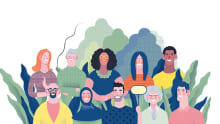5 ways of driving inclusion in your organisation

As is said that the tough situations build strong people, so is the case for the organisations. The unprecedented time of COVID-19 pandemic has made the business case for diversity and inclusion in the organisations stronger than ever before.
In order to face unique challenges, organisations need people with unique thought-processes: the kind that emerges from truly diverse teams individuals; teams that exemplify diversity of thought, identities, gender, race, age, culture, ethnicity, sexual orientation, abilities, talent, background, etc.
Many researches have shown that the diverse teams are demonstrably more successful and tend to outperform more homogeneous teams, in most business-case scenarios. This is because diverse teams tend to produce contextual variety; they often come up with creative, lateral, and innovative perspectives; they are easily able to avoid the perils of group-think; and the teams’ diverse strengths compensate for the blemishes of any individual member. Diversity is what drives better insights, more informed decisions, better products, better customer experiences, better employee experiences and employee retention.
So, if diversity is a value worth pursuing, gaining, and leveraging, then inclusion is the practical expression of valuing diversity. Organisations that are market leaders in their respective sectors know well that their success is significantly an outcome of a diverse workforce thriving in an inclusive and engaged workplace.
Inclusion is not just an environment but a continued commitment. It defines the organisations’ orientation towards its people. An inclusive workplace ensures that every individual in the organisation feels a deep and abiding sense of respect, value, purpose, and meaningful contribution towards the organisation’s common goals, and to this end, each one has equal access to all the opportunities and resources within the organisation.
For any organisation to truly leverage the strengths of its diverse workforce, it must work persistently towards building an inclusive workplace.
Here are five imperatives for driving inclusion to the forefront of an organisation’s agenda:
Embracing diversity starts from the top
A successful diversity strategy begins with Leadership. Leaders of an organisation are at a pivotal position of showing their conviction to the cause and of setting the tone for the rest to follow. They need to truly embrace and harness the power of diversity – of thought, of experiences, of expertise, of backgrounds, and of uniqueness – in order for this mind set to permeate across the entire organisation.
Leadership and HR Teams must closely monitor the overt and implicit signals being sent out that have implications for D&I agenda. For instance, have you scrutinized whether your employee promotion policies or career progression opportunities invariably favour a particular group, gender, or skillset over others?
Signs and signals such as these can make employees feel valuable or valueless in the organisation.
Re-examine internal processes and policies to ensure they support inclusion goals. This is the time of the year when Business Teams and HR Teams are working on the Annual Business Plans, wherein diversity ratios are on the agenda for discussion. Examine these plans with an inclusion lens to set the ball rolling in the right direction.
The tenets of Inclusivity are captured in the 3 Es of Encouragement, Empowerment, and Empathy. Encourage employees by empowering them in their environment with empathetic leadership.
Build a culture of psychological safety
Studies have shown that one of the greatest indicators of high inclusion levels at the workplace is the experience of psychological safety.
Psychological safety is the belief that one will not experience rejection, insult, anger, embarrassment or ridicule for expressing oneself freely and authentically at the workplace. Trust and mutual respect are the two fundamental pillars of psychological safety. Psychological safety nurtures the ability of every person to speak with candor, openly, and freely. Herein, people believe that they can speak candidly about their ideas, questions, concerns, and even mistakes. Leaders and Team Managers play a key role in building a culture of safety and respect such that no individual team member feels afraid of being vulnerable.
While a psychological safe workplace has a great bearing on the employees’ performance and mental wellbeing, it has a greater impact on the organisations’ performance, health, resilience and its strength to bounce back in the tough times.
Organisations with higher psychologically safe environments relish loyal employees, who remain steadfast and committed to the whole, even during the times of great crises and challenges.
There can be no inclusion without equality
Unless every diverse member of a diverse workforce feels nonetheless equal with their peers at the workplace, inclusion cannot happen. The starting point of inclusion is the Self-belief of being equal.
Equality is inseparable from inclusion. An inclusive workplace is also one where every person knows as a fact that they have equal access to resources and opportunities as their peers and colleagues at their level. Once ‘I’ start feeling equal, then its strong ground to demand for a ‘slot’, if not given one!
Just as diversity is the recognition of every individual’s identity, equality is the recognition of every individual’s dignity. And inclusion is the celebration of all of these.
As is said by Henry Ford, “Whether you think you can or think you can’t, you are right.”
Talent market workplace
For the corporations to be future ready, a Talent Market Workplace focusing on the skill set for the job needs to take the lead. Using AI and smart algorithms, the talent market workplace can tie relevant opportunities to the employees and allow organisations to benefit from the untapped ambition and abilities of the diverse people it employs. This can further foster inclusion of a diverse workforce. Through the talent market workplace, the focus needs to be on the Individual Development Plans, Leadership Development Plans, Upskilling and Reskilling, thus giving a fair and equal opportunity to a diverse workforce.
More so, in unprecedented times like these, the necessity and the urgency of the D&I skill sets has become multi-fold to sail through the RUPTured World. RUPT - Rapidly changing, Uncertain, Paradoxical and Tangled
The power of sisterhood
Narrowing down on the gender dimension of diversity, female colleagues need to acknowledge, celebrate, and leverage the “The Power of Sisterhood.”
This means the power that we derive from other female colleagues seeing how they managed the similar situations in their professional journeys, the power of learning from each other, the power to support each other and the power to be brand ambassadors for each other. And, this is certainly not about creating clubs or groups, but in the true sisterhood, we hold each other up to be comfortable to share both the ups and the downs, to be able to see the best of who we are.
Despite much effort to rebalance this, gender-ratios in many organisations continue to remain skewed against women, although in some sectors, women are increasing their presence gradually. With an unequal representation, it is vital that women leverage the Power of Sisterhood to further thrive in the corporate world.
The courage to be vulnerable is a strength. Women in the corporate world need to realize that valuable assets like compassion, emotions, and passions can be leveraged effectively for career growth by becoming highly empathetic leaders with higher levels of Emotional Quotient than people with traditional and outdated leadership styles.
To conclude, I unswervingly believe in what William Sloane Coffin Jr. said,
“Diversity may be the hardest thing for a society to live with, and perhaps the most dangerous thing for a society to be without”.
--
Note: All views are personal and have no direct reference to any individual or the organisation.
















